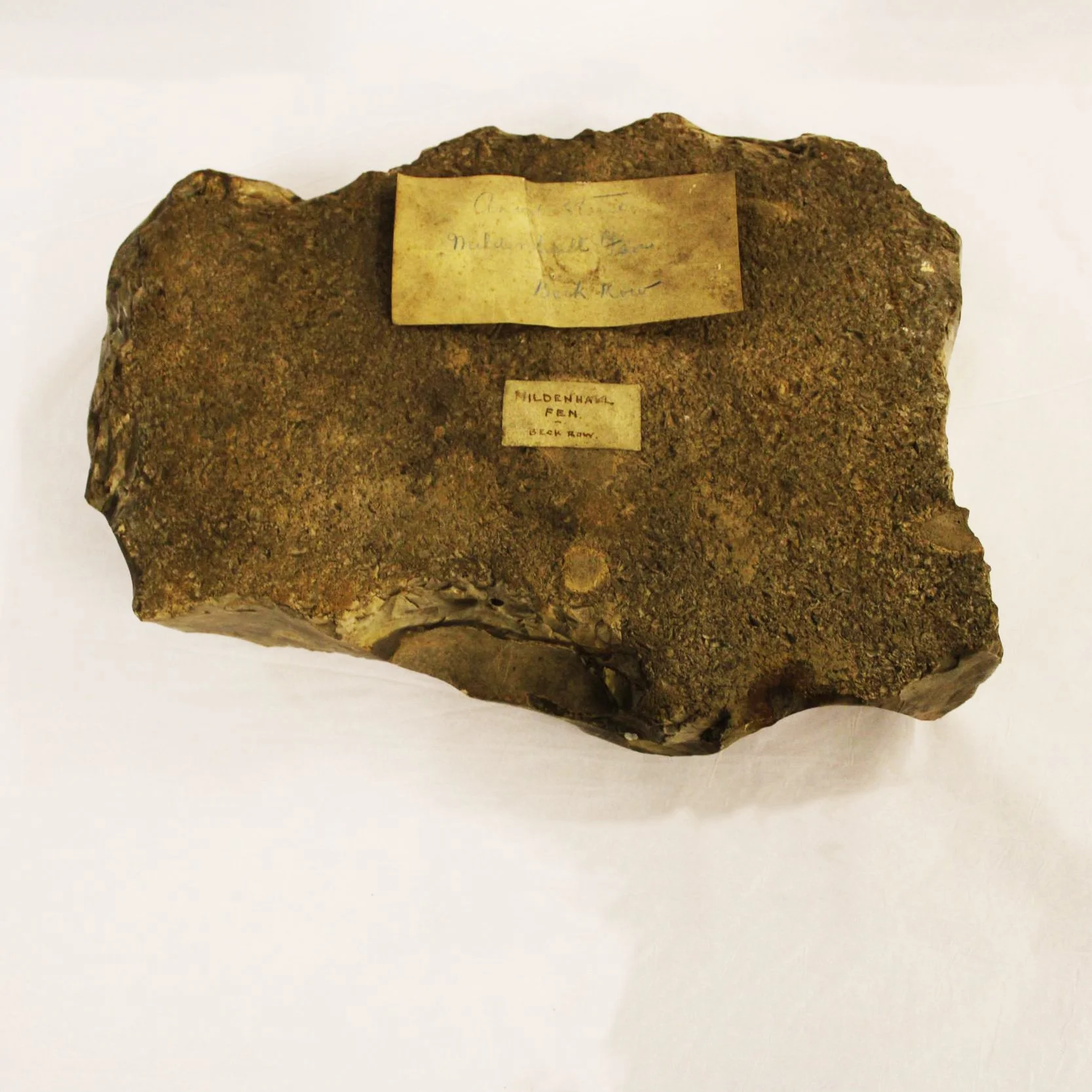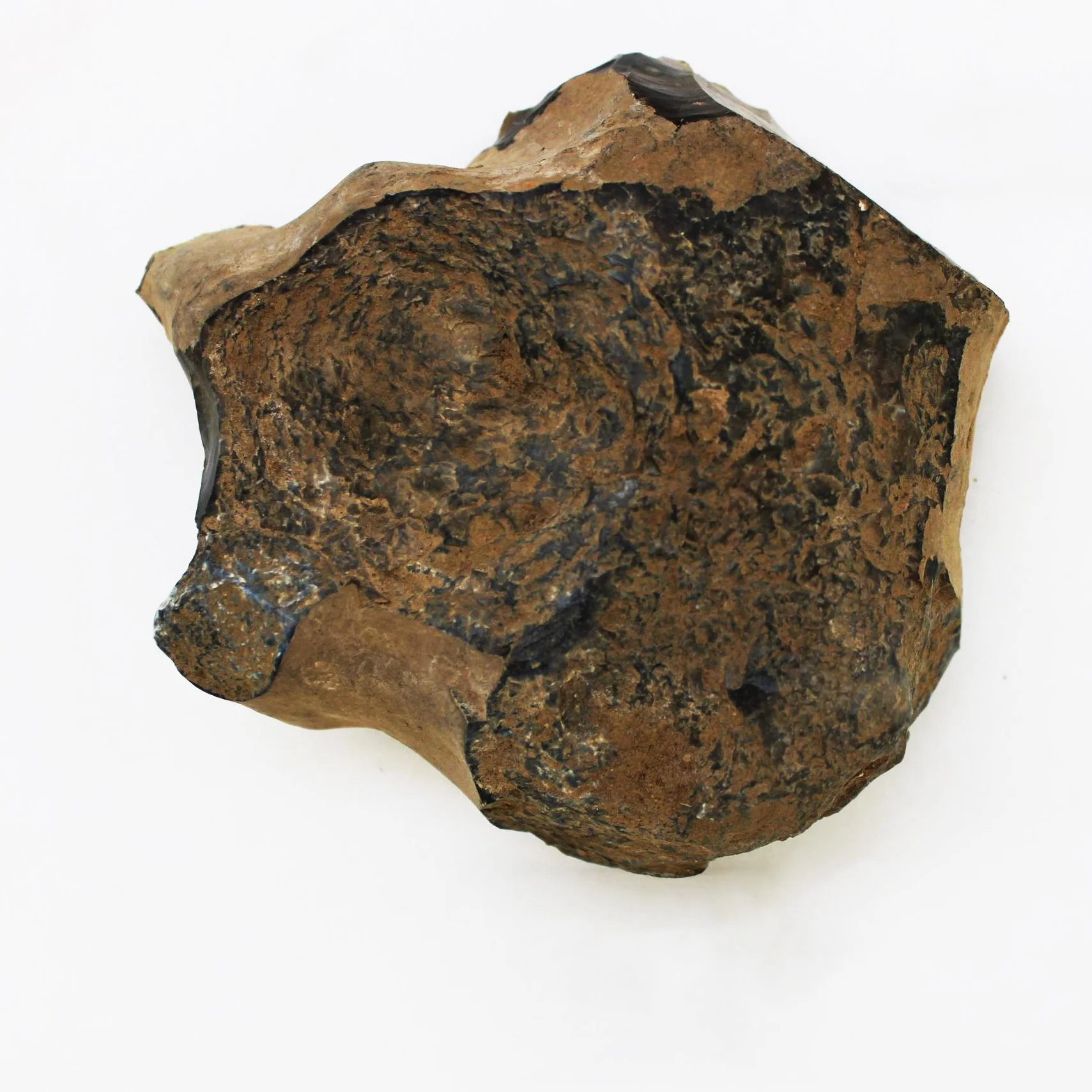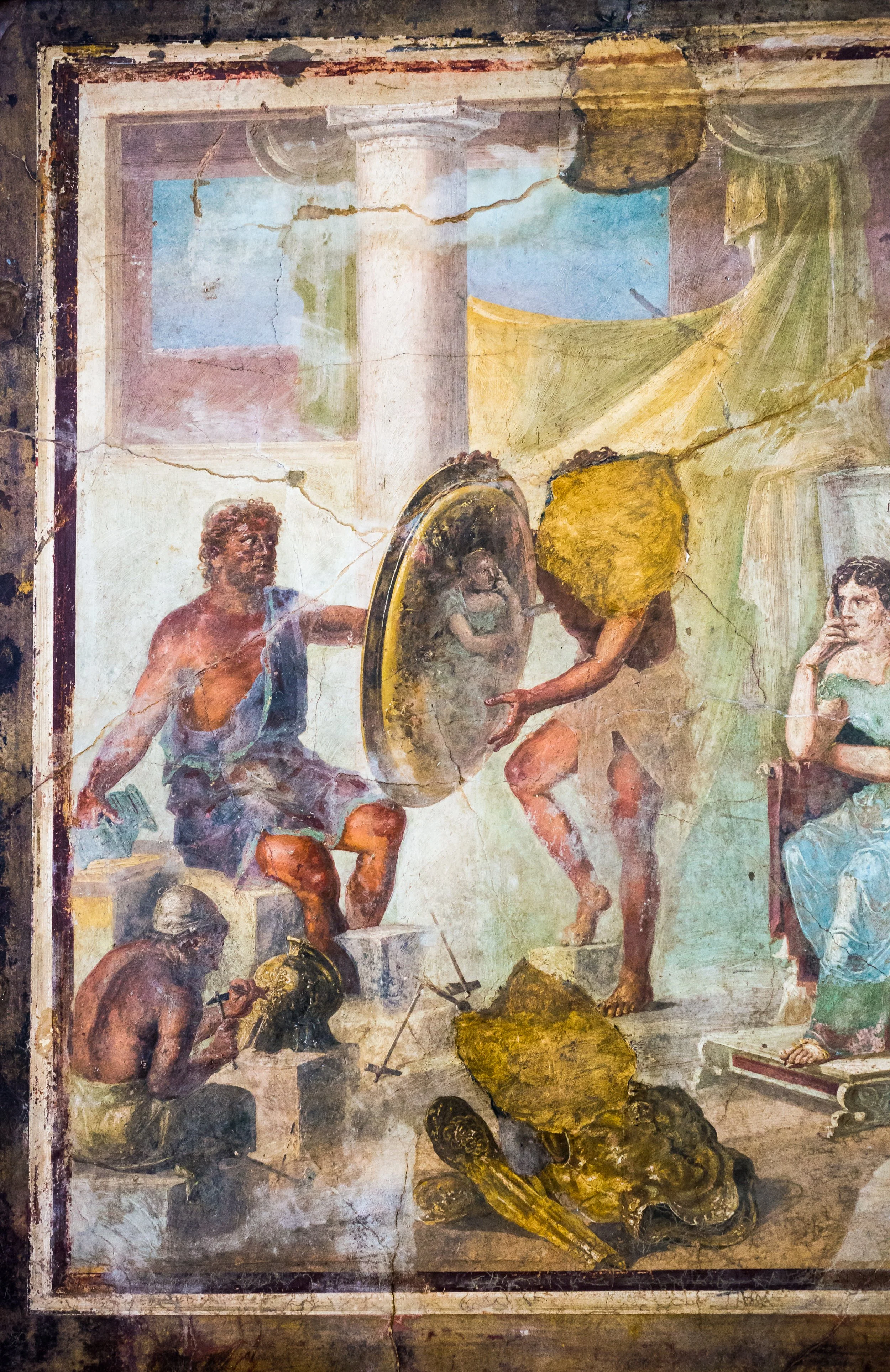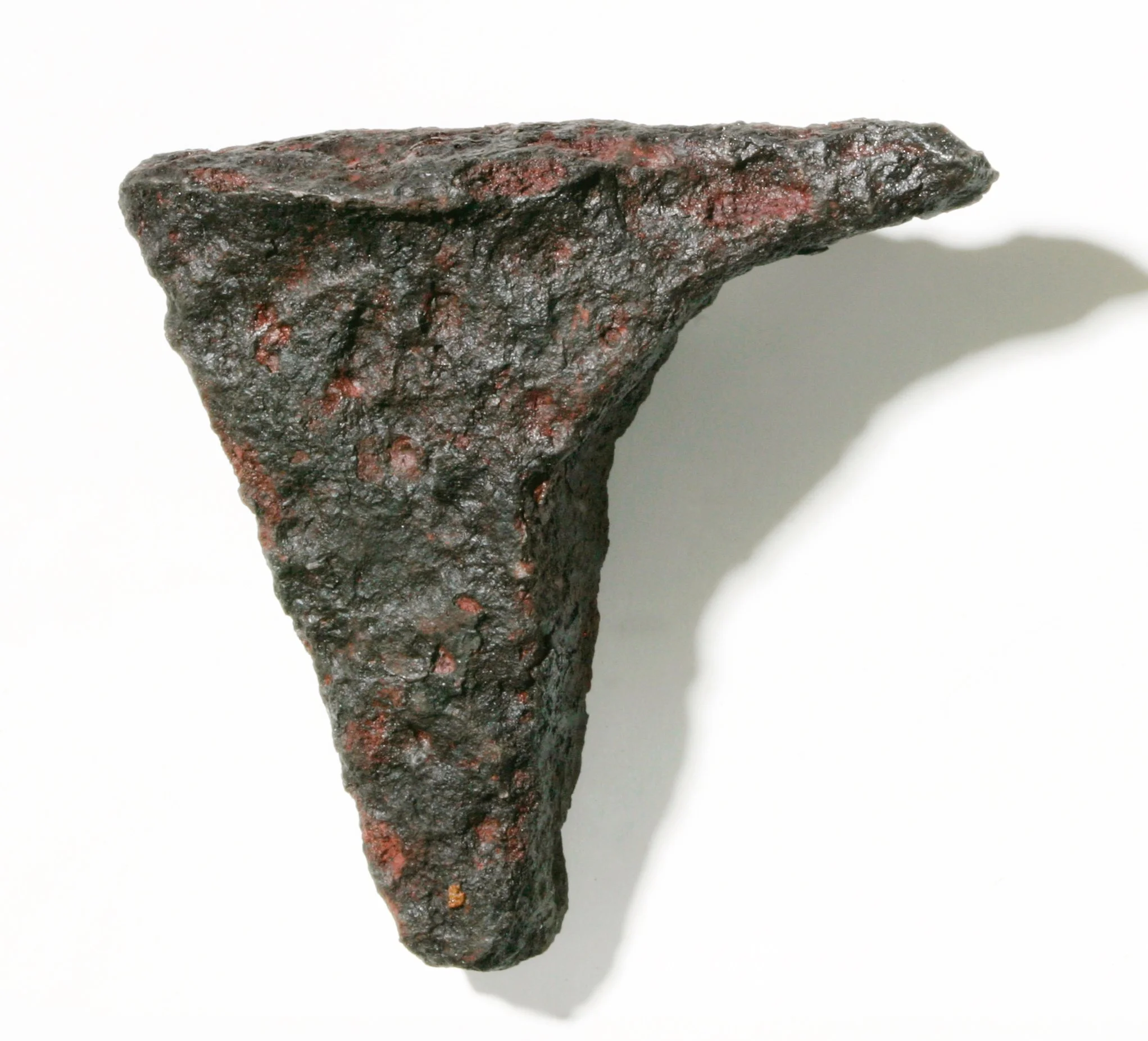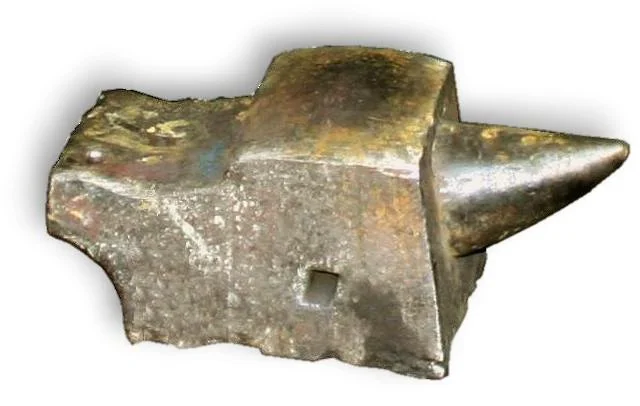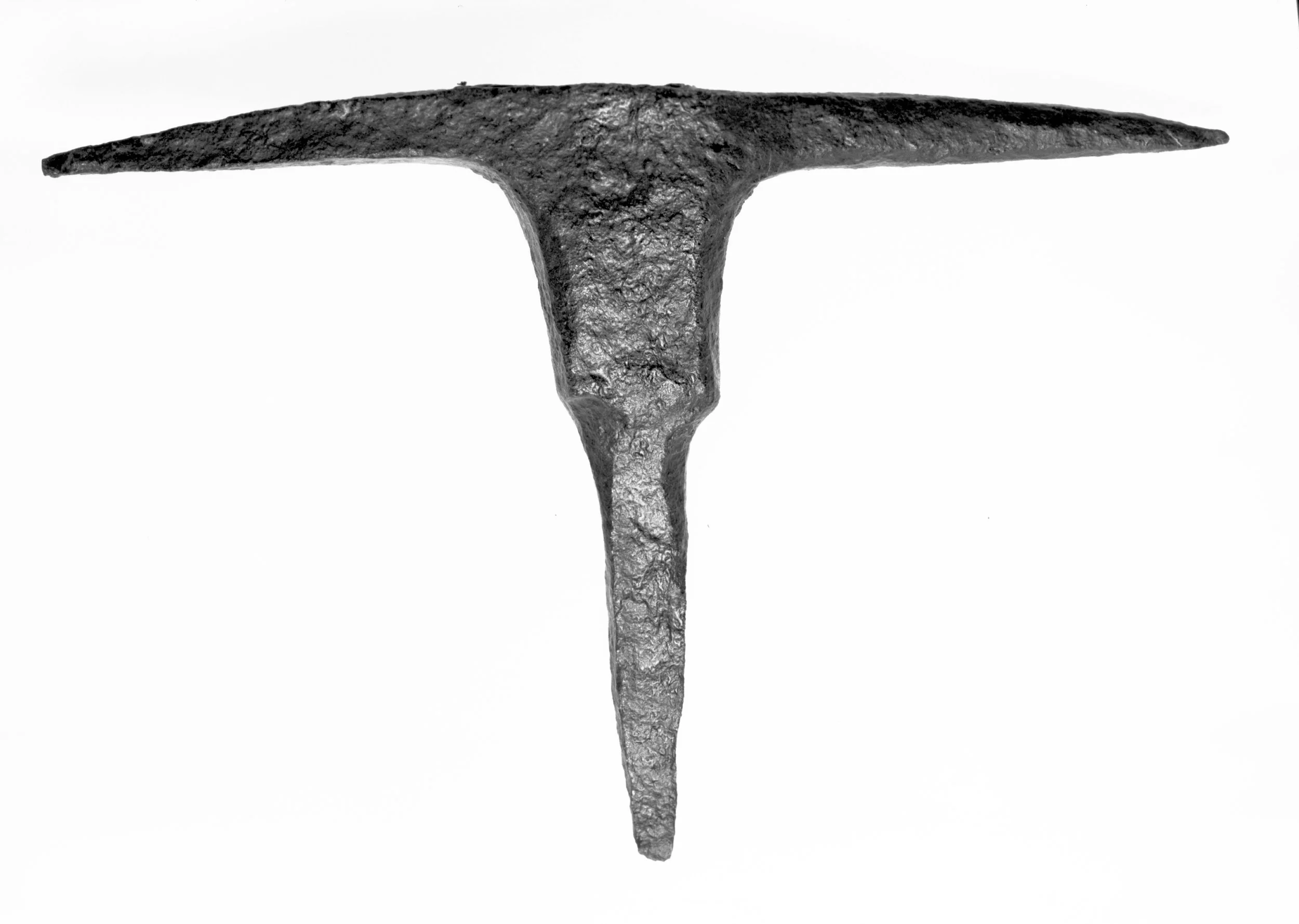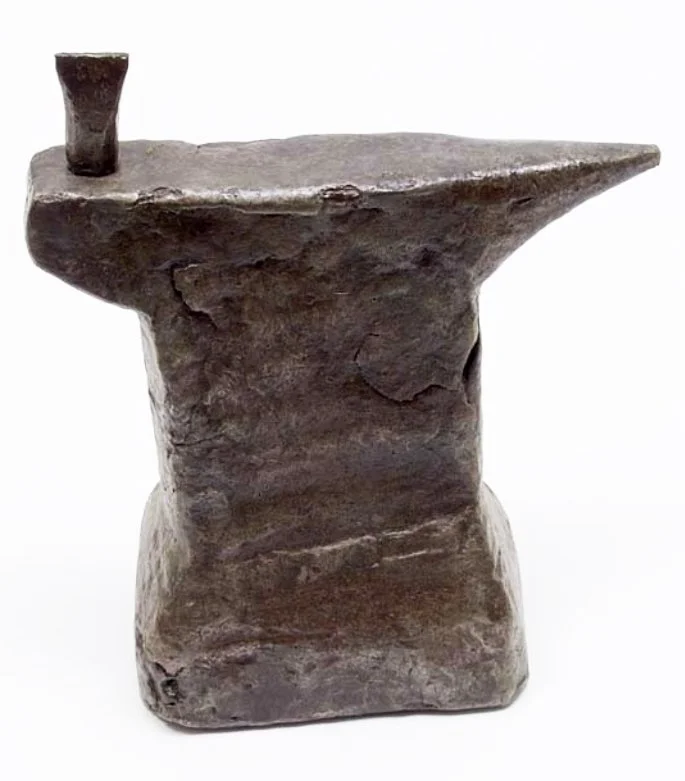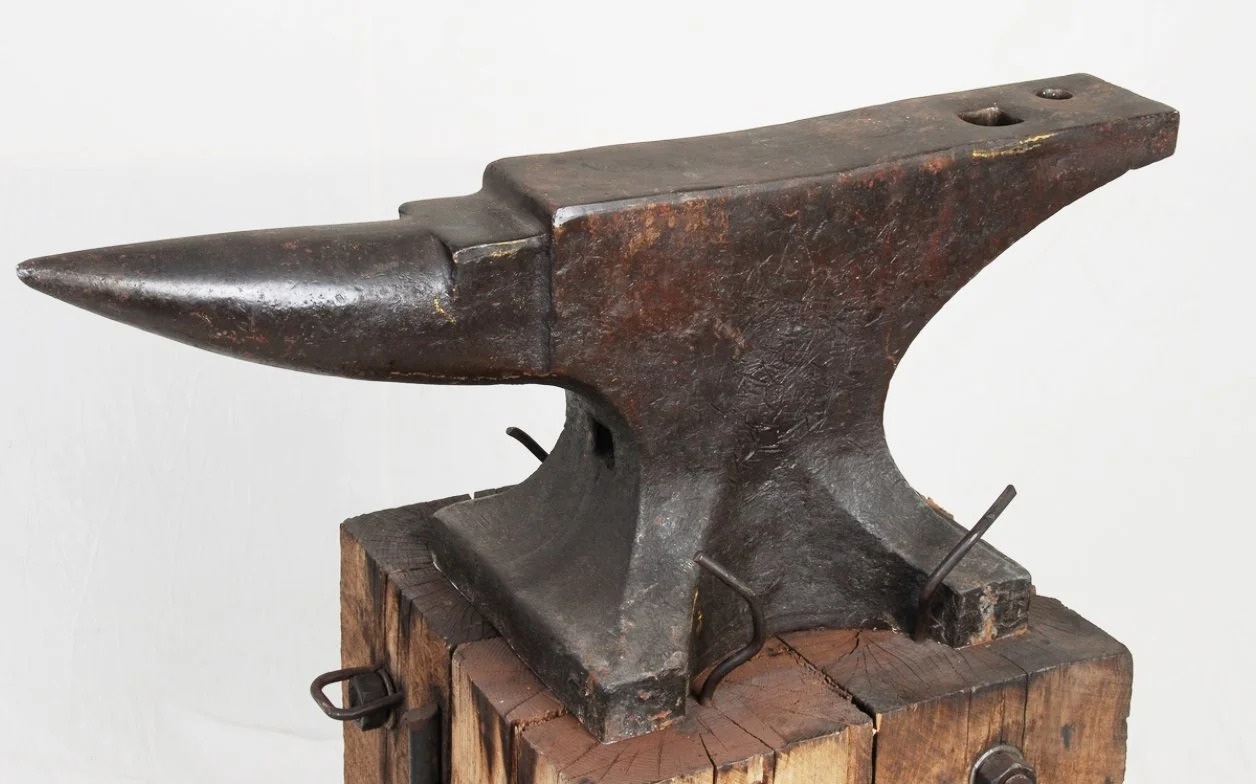From the very beginning of humanity’s use of tools we have needed anvils. From the Neolithic period and the knapping of flint for tool‑making, to the jeweller’s miniature stakes and the colossal industrial hammers weighing many hundreds of tonnes.
The timeline of anvil development quickly becomes rather complicated, as different parts of the world entered the Bronze and Iron Ages at different times. On top of that, some areas and civilisations virtually skipped parts of this progression—for instance by trading with colonising Europeans and acquiring ready‑made tools. This article is therefore not intended as an absolute truth about the evolution of anvils, but rather a collection of snapshots centred on Europe and the Nordic countries.
In the beginning the terms hammer and anvil were fairly loose concepts. The hammer was whatever you held, and the anvil whatever you struck against. Initially these tools were probably used mostly to crack nutshells, bones to get at the marrow, or to open crabs, lobsters, or other creatures with an exoskeleton. For the most part people would have used more or less random stones of a convenient size, but we can imagine another scenario: a mis‑strike—or simple wear—might split one of the stones, yielding a relatively sharp edge, and early humans would quickly have realised what such an edge could be used for.
The earliest finds of stone tools come from Lomekwi in Kenya and have been dated to 3.3 million years ago—around a million years before the oldest fossil of the genus Homo. Several stones were found that show signs of having been used for hammering and as an anvil. The slightly younger site of Oldowan in Tanzania, about 2.6 million years old, contains many objects that have clearly been shaped to provide a sharp cutting edge. Much of this was achieved by striking stones against one another: first by splitting rounded stones upon an anvil, then by knocking off flakes to produce a sharp edge.
The British Museum has two Neolithic flint anvils in its collection. They bear clear traces of repeated hammering, and different sides of the stones show different wear patterns.
Let us now leave stones behind and turn to metalworking. In The Iliad, written by Homer around 700 BCE, there is a description of Hephaestus forging the armour and shield for Achilles:
“He threw copper on the fire, sturdy tin, precious gold and silver, and laid a great anvil upon the block. In one hand he seized the massive hammer, in the other his tongs.”
Hephaestus depicted on a drinking cup, handing the weapons and armour to Thetis, Achilles’ mother, made in the 5th century BCE.
Fresco from Pompeii. Hephaestus is again shown working armour for Achilles, but now with two assistants while Thetis looks on.
Note the hammers made for repoussé, chasing and engraving, as well as several stones that were most likely used as anvils. Each probably had its own function and shape that made it suitable for shaping bronze plate in different ways. Nevertheless, it is somewhat risky to read too much into artistic depictions. It is unlikely that the artist possessed detailed knowledge of the tools the smiths used, especially when illustrating scenes several hundred years in the past. If they carried out any form of ‘research’ it was probably limited to a quick visit to the local smithy, a few sketches of how the work was done, and then a measure of artistic licence to make the scene fit the ancient story.
In Greece and the surrounding regions the Iron Age began from about 1000 BCE, but up to around 400–300 BCE bronze was still a common material. Alexander the Great’s army was equipped with iron weapons, yet most of their armour was still bronze.
Several anvils from this period have been discovered and described, but I have not been able to form a clear picture of what sizes were typical at the time.
Shown here are two bronze anvils from the British Museum. The one on the right weighs 146 g, is 67 mm long and is dated to 1300–800 BCE. The left‑hand anvil is said to weigh 161 g, be 48 mm long, with small flakes of gold hammered into its surface.
British anvil from around the year 400 CE, found in Bedfordshire, England. The stake has two loops on either side to prevent it being driven too far into the ground or into a stump in use. The anvil is thought to have been used for peening scythe blades—that is, cold‑forging the edge to work‑harden and sharpen the steel. It was discovered together with other tools and equipment related to agriculture and forestry.
There must certainly have been larger bronze anvils as well, and as soon as iron was being produced, iron anvils would also have appeared. Unfortunately, only a few archaeological finds survive that are old enough to illustrate this.
A Brief Digression: When smelting bloomery iron you obtain a bloom from the furnace that is very porous and needs several rounds under the hammer to be consolidated into a solid bar. In this process it is undesirable to forge the bloom directly; you simply want to pack it tighter. For that reason, it has been common to use a wooden block—often together with large wooden mallets—during bloom consolidation.
Let us leap forward in time, and a little farther north. In Egil Skallagrímsson’s Saga, written in the first half of the 13th century and describing the settlement of Iceland in the years 900–1000, we find this passage:
Norse original text, ca 1200:
Skalla-Grímr var járnsmiðr mikill ok hafði rauðablástr mikinn á vetrinn. Hann lét gera smiðju með sjónum mjök langt út frá Borg, þar sem heitir Raufarnes. Þótti honum skógar þar fjarlægir. En er hann fekk þar engan stein, þann er svá væri harðr eða sléttr, at honum þætti gott at lýja járn við, - því at þar er ekki malargrjót, eru þar smáir sandar allt með sæ, - var þat eitt kveld, þá er aðrir menn fóru at sofa, at Skalla-Grímr gekk til sjóvar ok hratt fram skipi áttæru, er hann átti, ok reri út til Miðfjarðareyja, lét þá hlaupa niðr stjóra fyrir stafn á skipinu. Síðan steig hann fyrir borð ok kafaði ok hafði upp með sér stein ok færði upp í skipit. Síðan fór hann sjálfr upp í skipit ok reri til lands ok bar steininn til smiðju sinnar ok lagði niðr fyrir smiðjudurum ok lúði þar síðan járn við. Liggr sá steinn þar enn ok mikit sindr hjá, ok sér þat á steininum, at hann er barðr ofan ok þat er brimsorfit grjót ok ekki því grjóti glíkt öðru, er þar er, ok munu nú ekki meira hefja fjórir menn.
English Translation, 1893 by W.C. Green
Skallagrim was a good iron-smith, and in winter wrought much in red iron ore. He had a smithy set up some way out from Borg, close by the sea, at a place now called Raufar-ness. The woods he thought were not too far from thence. But since he could find no stone there so hard or smooth as he thought good for hammering iron on (the seashore being all fine sand), one evening, when other were gone to sleep, Skallagrim went to the sea, and pushed out an eight-oared boat he had, and rowed out to the Midfirth islands. There he dropped an anchor from the bow of the boat, then stepped overboard, and dived down to the bottom, and brought up a large stone, and lifted it into the boat. Then he himself climbed into the boat and rowed to land, and carried the stone to the smithy and laid it down before the door, and thenceforth he hammered iron on it. That stone lies there yet, and much slag beside it; and the marks of the hammering may be seen on its upper face, and it is a surf-worn boulder, unlike the other stones that are there. Four men nowadays could not lift a larger mass.
This sounds more like a legend than a description of something that actually happened. Included with the Icelandic letters sent back to families in Norway was repeated mentions of the need to have millstones shipped across for grinding grain into flour. Once you have the means to transport stone by boat, there is little difference whether you are sending millstones or anvil stones. Perhaps this tale of Skallagrim is a fanciful account of him carrying his new, large anvil stone ashore single‑handedly?
Why this focus on anvil stones? Even though iron had become a common trade commodity and by this time had out‑competed bronze in almost every area except decoration and jewellery, iron was still very expensive. Although it is possible to perform heavy work on a small anvil, we all know that a larger anvil makes large jobs easier—and, after all, stone was practically thrown at you for free.
On that basis, I believe stone anvils were far more common in earlier times than we tend to assume. Stone also has several advantages over iron beyond mere availability in substantial sizes. It is worth noting that there are many different rock types, each used for different things, but in very broad terms: stone possesses excellent compressive strength, is harder than iron, is relatively easy to shape and polish, and has poorer thermal conductivity, meaning the workpiece lying on the stone cools more slowly.
The anvils we have found from the Iron Age, especially in Norway, have usually been small affairs by today’s standards—seldom more than five kilos in weight, up to 16 cm high, and with rather short horns if they had horns at all. These anvils were probably not limited to ironwork, but were doubtless used for finer crafts such as gold and silver too.
Viking anvils. Left: found near Grimstad, Norway. Right: found in Hol, Norway. Approximately 9 × 9 cm and 10 cm high. Photo both: Museum of Cultural History, Norway
Anvil of wood and iron, height c. 10 cm and weight c. 10 kg, from the Maldives. Photo: British Museum.
Traditional Chinese anvil. Photo: anvilfire.com
Moving forward towards the Middle Ages we see that anvils gradually become larger and heavier, yet still nowhere near as big as those we often see and covet today. With ever more iron in circulation there was now scope for specialised anvils and considerable local variation. Whereas virtually all Iron‐Age anvils had roughly the same shape —small face and stubby horn— from the Middle Ages and into the Enlightenment we can find anvils with distinctive features that can be traced geographically to different parts of the world and that were clearly used to make specific things.
Anvil for plate work from the Middle Ages, ca. 20 cm long. Found in Oslo. Photo: Museum of Cultural History
It is difficult to say exactly how anvil development proceeded in the Nordic countries. In pre‑industrial times iron was so costly that it probably paid to save every last scrap. Whether this extended to remelting scale and iron swarf is uncertain, but it is quite plausible that they aimed to reuse as much as possible.
All sorts of off‑cuts, old nails, and anything that broke or was rusting to pieces may well have been either cast into new stock or welded together and forged anew. I would argue that this reuse applied to anvils too, albeit perhaps not in so drastic a fashion.
The quality of iron before the Industrial Revolution was much poorer—or rather of a completely different type—than what we have today. Often known as wrought iron, or Lancashire iron here in Norway, it consists of alternating layers of iron and silica. This makes it easy to recognise, after a few weather‑beaten years it can take on a texture almost like woodgrain or stripes. Along many coasts around the world we can see remnants of such iron in mooring points, along piers or in old anchors set out as decoration. Due to the layered structure of iron and silica, wrought iron must be forged at a fairly high temperature to avoid the ends fraying and the stock splitting. Wrought iron was also generally a much softer material, and there are stories of many old smiths who gave up when modern mild steel took over the market around the turn of the century.
It should be mentioned, however, that no matter how hot you forge the iron, the anvil will wear, meaning the anvil will need maintenance. Today we have many modern aids and a completely different relationship with material cost. We can, for instance, grab an angle grinder and grind the face of the anvil flat. We can break out the welder and layer on more steel, or we can simply buy a new one. It costs money, but compared to the hourly wage in former times, today’s anvils are almost free—at least if you are making your living working at the anvil.
Forged anvil c. 22 cm high, 34 cm long with a 6 cm wide face.
Typical forged farm-style anvil from Elverum, Norway, with cut-off tool.
What I think is more likely, as regards to maintaining anvils in earlier times, is that the anvil was most probably reforged, with new layers of iron welded on as the years went by, rather than being filed down or a completely new anvil forged from scratch. Some indications of this can be seen on the old farm anvils we have here in Norway. They often have a great many forge‑welds and frequently look like an enormous patchwork of iron.
Old forged anvil from Austria with the characteristic steps on the foot, and with square holes beneath the horns and on the underside for handling during production. Photo: anvilfire.com
Anvil dated 1736. The back is completely flat; the front slopes forward slightly to receive blows from a striker. The anvil can be laid with the back down and the two hollow shapes at the front used as bottom swages for plate work. Probably German. Photo: Wikipedia.org
One problem in dating anvils—and forged iron generally—is that iron itself cannot be dated in any proper way. New techniques have emerged that allow us to date the carbon trapped within the iron, which can tell us roughly when the iron was produced. We can also analyse the composition of the material, look for impurities and substances we know are typical of certain production methods and specific places in the world, that were only operating during a given period. Yet even if we could determine all that we would still be on shaky ground. It is very easy to forge and reuse iron, and a particular lump of iron may have been reforged many times over the centuries. The best way of dating is therefore to use other associated finds as an indication of the period. In short, there is a good deal of educated guesswork involved, but we are steadily gaining greater insight and a better picture of what the craft of blacksmithing looked like thousands of years ago, and up to the present day.
Example of a modern London‑pattern anvil from Framnæs Mekaniske Verksted, Sandefjord. Probably 1910. Photo: Digitalt Museum, Vestfold County Museum.
Interested in more articles like this? Join either the Norwegian, Swedish og Danish Blacksmithing Society to receive JERN, a Scandinavian blacksmithing magazine, three times a year.
You can also support my work directly with a small monthly contribution at Patreon.com/rasmusloen, or you can make a one-time contribution at paypal.me/rasmusloen . Your support helps me write more articles like this and produce more content on blacksmithing and its history.


